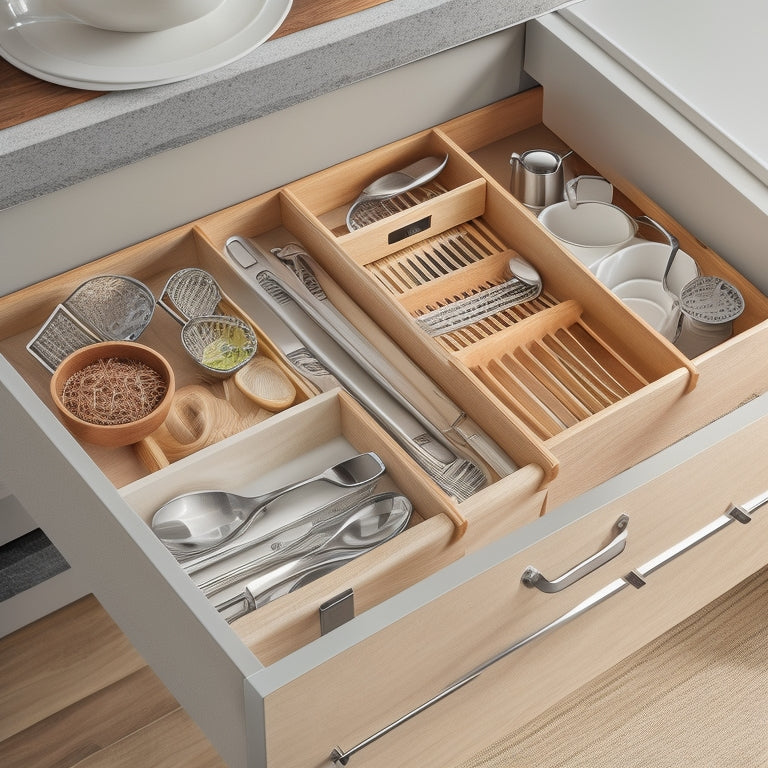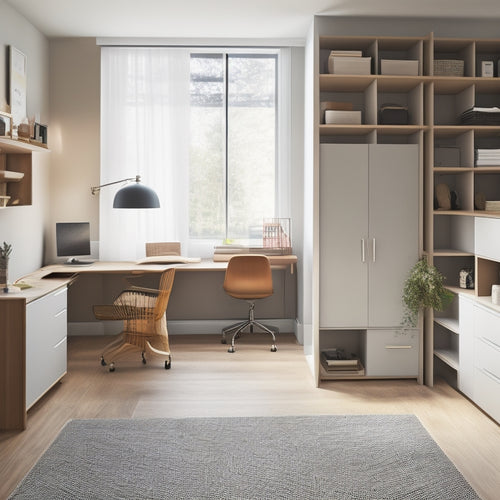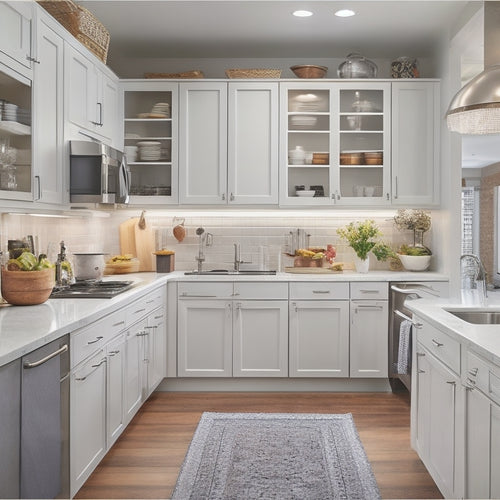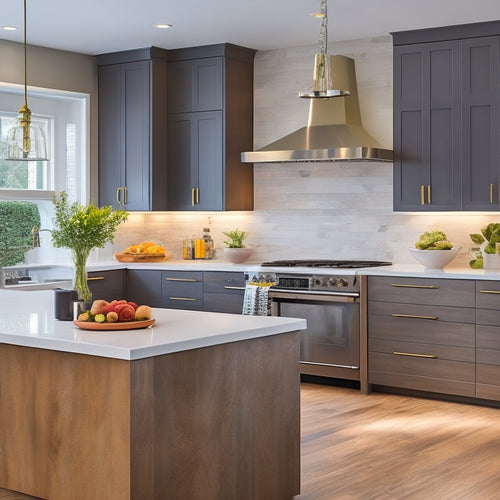
Custom Utensil Inserts for a Clutter-Free Drawer
Share
You're likely tired of digging through a cluttered kitchen drawer to find the utensil you need, and a custom utensil insert can be the solution you've been looking for to reclaim that space. To create an efficient and organized space, start by measuring your drawer's length, width, and height to determine the ideal insert size. Consider the type and number of utensils you need to store, and choose a material that fits your design style and budget, such as bamboo, recycled plastic, or stainless steel. By designing custom compartments and allocating space thoughtfully, you'll be well on your way to a clutter-free drawer that makes cooking and entertaining a breeze - and there's more to investigate to make it perfect.
Key Takeaways
- Measure your kitchen drawer's length, width, and height to ensure a perfect fit for your custom utensil insert.
- Choose durable and sustainable materials like bamboo, recycled plastic, or stainless steel for your insert.
- Design custom compartments that group utensils by type, frequency of use, and size for optimal storage and accessibility.
- Consider ergonomic slot design with customized dimensions for easy retrieval and reduced strain on hands and wrists.
- Assemble and install your custom insert by cutting dividers to fit, attaching them to the base, and optimizing compartment arrangement.
Measuring Your Kitchen Drawer Space
About half of your kitchen utensils are probably jumbled together in a single drawer, making it difficult to find what you need when you need it. To maintain a clutter-free environment, it's crucial to evaluate living spaces for functionality and optimize storage solutions.
To create a custom utensil insert, you'll need to measure your kitchen drawer space accurately. Take out your utensils and group them by type, such as cooking utensils, baking utensils, and serving utensils. Measure the length, width, and height of your drawer to determine the maximum dimensions of your insert.
Record these drawer dimensions to guarantee your insert fits perfectly. Consider the size and shape of each utensil type to design an insert that accommodates them efficiently. With precise measurements, you'll be able to create a custom insert that keeps your utensils organized and within reach.
Choosing the Right Utensil Insert
You'll want to evaluate the durability and aesthetic of your utensil insert materials, as they'll impact the overall functionality and look of your custom setup.
The ideal insert size will depend on the specific utensils you plan to store and the space you've measured in your kitchen drawer.
Utensil Insert Materials
When selecting a utensil insert, the material it's made of plays an essential role in its performance and longevity.
You'll want to reflect on materials that not only fit your utensil insert aesthetics but also align with your values. Sustainable materials, such as bamboo or recycled plastic, are great options for those who prioritize the environment.
Durable materials like stainless steel or silicone guarantee your insert withstands daily use. If you're looking for a more premium feel, wood or ceramic inserts can add a touch of sophistication to your kitchen.
Ultimately, the right material will enhance the functionality and longevity of your utensil insert, giving you a clutter-free drawer that meets your needs.
Optimal Insert Size
The utensil insert's size is essential in maximizing your drawer's storage capacity and ensuring easy access to your utensils.
You'll want to choose an insert that fits your drawer's dimensions perfectly. Measure your drawer's interior to determine the ideal insert dimensions.
Consider the type and number of utensils you'll be storing, as well as the space you need to access them easily. A custom insert that's too small won't hold all your utensils, while one that's too large will leave wasted space.
Designing Custom Utensil Compartments
When designing custom utensil compartments, you'll want to take into account the ideal layout to maximize storage and accessibility.
This involves grouping utensils by function or frequency of use to create a logical and efficient organization system.
Optimal Compartment Layout
Within the confines of your custom utensil insert, ideal compartment layout is vital to maximize storage efficiency and accessibility.
You'll want to allocate space thoughtfully to guarantee each utensil has a designated home, preventing clutter and promoting ease of use. Consider the frequency of use and categorize utensils accordingly, placing often-used items in easy-to-reach areas.
Balance functionality with aesthetics, making sure your compartment layout complements your drawer's overall design. A well-designed layout won't only improve utensil accessibility but also enhance your drawer's aesthetics.
Utensil Grouping Strategies
As you begin designing custom utensil compartments, consider the utensil grouping strategies that will make your storage system truly functional.
You'll want to categorize utensils by type, such as baking, cooking, or serving, to guarantee easy access and visibility. Grouping similar utensils together, like all your spatulas or whisks, will maximize storage efficiency.
Consider the frequently used items and prioritize their placement in the most accessible areas of the drawer. Additionally, think about the overall drawer aesthetics and how the compartment design will reflect your personal style.
Ergonomic Slot Design
You've carefully considered utensil grouping strategies to guarantee your storage system is functional and visually appealing.
Now, it's time to focus on designing custom utensil compartments that maximize ergonomic benefits. By creating slots with customized dimensions, you'll assure easy retrieval and storage of each utensil. This thoughtful approach will reduce strain on your hands and wrists, making meal prep a more comfortable experience.
Consider the slot accessibility, too, as you design the compartments. Make certain the slots are wide enough for easy insertion and removal, but not so wide that utensils fall out.
With carefully crafted compartments, you'll enjoy a clutter-free drawer that's both functional and comfortable to use.
Materials for DIY Utensil Inserts
What kind of materials do you need to create custom utensil inserts that fit your specific needs and design preferences?
You'll want materials that are durable, easy to work with, and fit your budget. For eco-friendly options, consider using reclaimed wood, bamboo, or recycled plastic. These materials aren't only sustainable but also add a unique touch to your utensil organizer.
If you're on a tight budget, budget-friendly solutions like plywood, MDF, or cardboard can get the job done. You can also repurpose old materials like cardboard tubes, paper towel rolls, or plastic containers to create a one-of-a-kind utensil insert.
Choose materials that align with your design style and meet your functional needs.
Assembling the Utensil Organizer
With your materials in hand, it's time to bring your custom utensil insert to life. Start by cutting the dividers to the desired length, ensuring they fit snugly in the drawer.
Assemble the compartments by attaching the dividers to the base using the chosen adhesive or fasteners. Arrange the compartments according to your utensil organization tips, optimizing the drawer space for maximum efficiency.
Consider the frequency of use and size of each utensil when allocating space. By doing so, you'll create a clutter-free environment that streamlines meal prep and cooking.
Remember to leave some flexibility in the design, allowing for future adjustments as your utensil collection evolves.
Installing and Adjusting the Insert
Now that your custom utensil insert is assembled, it's time to install it in your drawer. Verify the drawer is empty and clean to facilitate a smooth installation process. Remove any existing dividers or organizers to make room for your new insert.
| Insert Installation Tips | Adjusting Drawer Fit | Additional Considerations |
|---|---|---|
| Measure the drawer's interior to verify a snug fit | Check the insert's width and adjust as needed | Use a soft cloth to wipe down the drawer and insert |
| Place the insert in the drawer, aligning it with the back | Test the fit by closing the drawer gently | Avoid using force, which can damage the insert or drawer |
| Secure the insert with the provided fasteners or adhesive | Make adjustments to the insert's dividers as needed | Refer to the manufacturer's instructions for specific guidance |
Follow these steps and tips to verify a successful installation and a clutter-free drawer that meets your organizational needs.
Frequently Asked Questions
Can I Use a Utensil Insert in a Drawer With a Non-Standard Size?
You can definitely use an insert in a drawer with non-standard dimensions. Look for adjustable inserts that can be customized to fit your unique space, ensuring a perfect fit and maximum organization.
How Do I Clean and Maintain My Custom Utensil Insert?
Get a handle on cleaning your custom utensil insert by regularly wiping it down with gentle cleaning materials and following these maintenance tips: dry thoroughly, avoid abrasive scrubbers, and oil wooden components to keep it in top shape.
Are Custom Utensil Inserts Suitable for Heavy or Bulky Kitchen Tools?
You'll find custom inserts suitable for bulky tool organization, offering heavy utensil support, but consider the material and design; sturdy materials like wood or thick plastic can handle heavy loads, while dividers and compartments help keep items organized.
Can I Add or Remove Compartments From My Utensil Insert Later?
As you orchestrate your kitchen's harmony, you'll appreciate the flexibility to adapt: yes, you can add or remove compartments from your utensil insert later, thanks to its removable compartments and adjustable design, allowing you to tailor your storage to your changing needs.
Will a Custom Utensil Insert Fit in a Drawer With a Pre-Existing Organizer?
You'll want to verify the custom utensil insert fits seamlessly with your existing drawer organizer. Measure your drawer dimensions carefully and check the insert's compatibility with your current organizer to assure a perfect fit.
Related Posts
-

7 Essential Storage Hacks for Small Spaces
You're likely no stranger to the frustrations of living in a small space, where clutter can quickly accumulate and ma...
-

Why Narrow Kitchens Need Space-Saving Solutions
In your narrow kitchen, every inch is precious real estate. You know how quickly clutter can take over, making meal p...
-

Smart U-Shaped Kitchen Remodeling Solutions
You're undertaking a smart U-shaped kitchen remodeling project, and optimizing space efficiency is key to creating a ...


